Let me share why I fell in love with making Vigan longganisa at home. Growing up, I thought these garlicky sausages could only be bought from the streets of Vigan. But when my Lola taught me how to make them, I was surprised at how simple it really is.
Unlike the sweet longganisa you usually find in stores, this Vigan-style version is packed with garlic and has this amazing tangy flavor. Sure, it needs a few days in the fridge to develop its flavors, but once you try this homemade version with your morning rice and eggs, you'll never go back to store-bought again.
I've made this recipe countless times now. And whether you're an Ilocano missing home or just someone who loves good Filipino breakfast, this recipe is a keeper.
Cultural Notes
Vigan longganisa is a heritage food that reflects the rich culinary history of Ilocos Sur. Unlike its sweeter counterparts from other regions, Vigan's version is known for its garlic-forward taste and distinctive use of native vinegar. This recipe has been passed down through generations of Ilocano families.
Jump to:
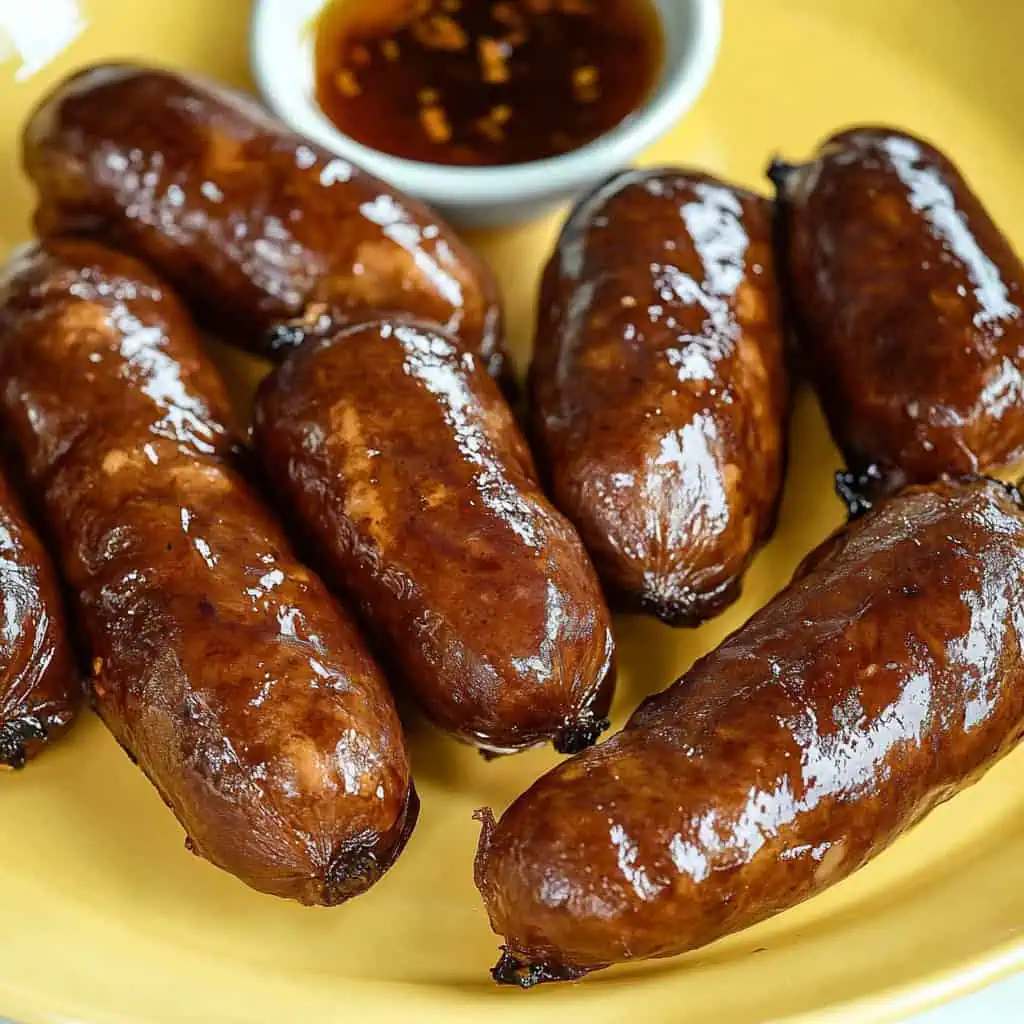
Why You'll Love This Recipe
- Authentic Ilocano flavor passed down through generations
- Can be made with or without casings (may gawing may balat o wala)
- Perfect make-ahead breakfast protein
- Rich garlicky-vinegar taste unique to Vigan
- Versatile - can be served for breakfast, lunch, or dinner
- Creates that nostalgic Filipino breakfast experience
Ingredients
This carefully balanced combination creates authentic Vigan longganisa's distinctive character. The pork and fat provide rich texture, while garlic delivers the signature pungent flavor. Brown sugar adds subtle sweetness, counterbalanced by vinegar's tang. Soy sauce contributes umami depth and natural coloring.
Bay leaf, paprika, and black pepper round out the flavor profile with warm, aromatic notes that develop during curing. The optional red pepper flakes add a gentle heat for those who enjoy a subtle kick.

- 1 kg lean pork meat, minced
- ¼ kg pork fat, minced
- 1 ½ heads garlic, crushed
- ⅓ teaspoon ground bay leaf or 1 leaf finely chopped
- 3 tablespoons brown sugar
- ¼ cup soy sauce
- ⅓ cup apple cider vinegar
- Salt to taste
- 2 teaspoons sweet paprika
- 1 teaspoon coarsely cracked black pepper
- 1 teaspoon red pepper flakes (optional)
Choose One:
- Sausage casing
- 3 tablespoons cornstarch (for skinless version)
Equipment
- Large mixing bowl - For thoroughly combining all ingredients and allowing flavors to meld
- Meat grinder or food processor - To achieve the perfect texture if using whole cuts of meat
- Sausage stuffer - If using casings; helps create consistent, well-packed sausages
- Kitchen twine - Essential for tying off sausage links at equal intervals
- Plastic container with lid - Creates the ideal environment for curing the sausages
- Heavy-bottomed skillet or kawali - Distributes heat evenly for perfect browning
- Meat thermometer - Ensures food safety by confirming proper internal temperature
- Wax paper - Important for wrapping skinless versions to maintain shape during curing
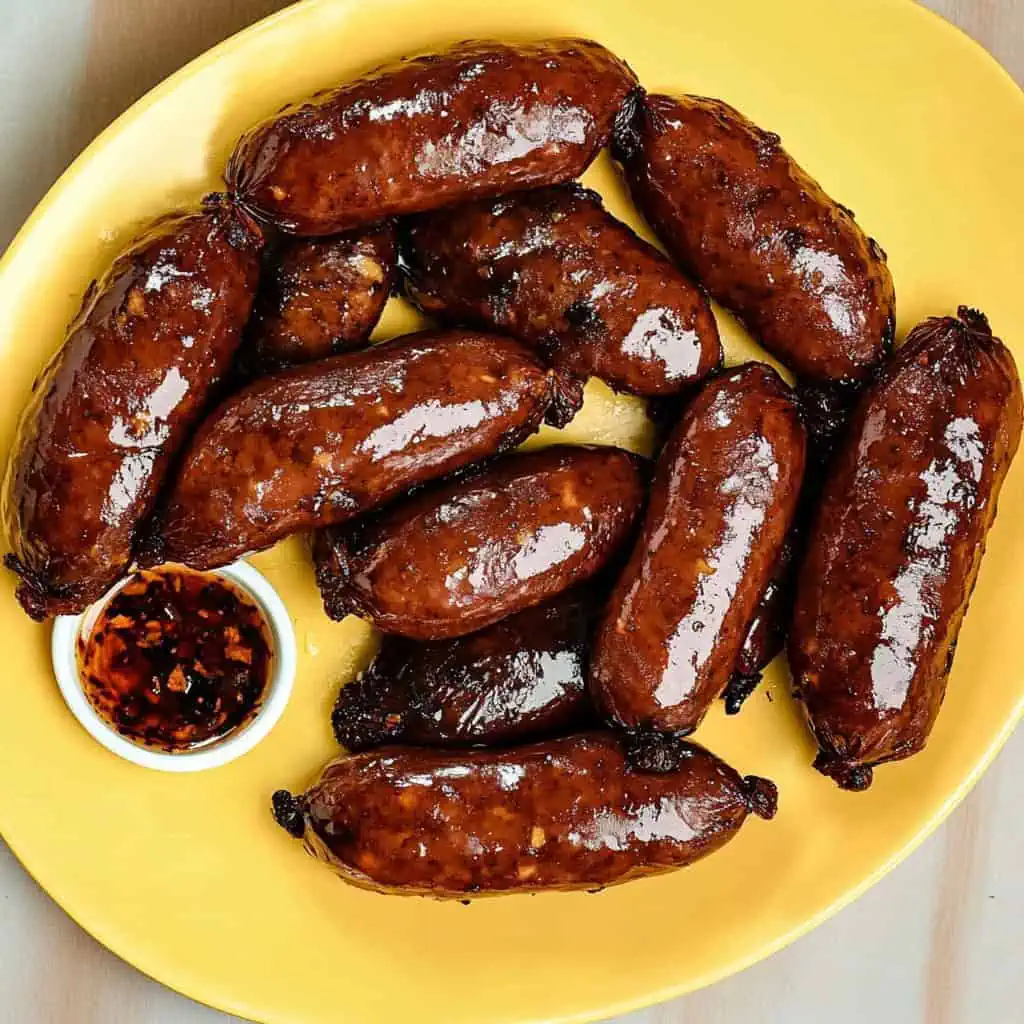
How To Make
- Combine the minced pork meat, pork fat, crushed garlic, ground bay leaf, brown sugar, soy sauce, apple cider vinegar, salt, sweet paprika, black pepper, and red pepper flakes (if using) in a large bowl. Mix thoroughly until well incorporated. Let this mixture rest for 1 hour to allow the flavors to begin melding.
- If using casings, carefully stuff the meat mixture into the sausage casings, making sure to avoid air pockets. Twist and tie the casings with kitchen string every 4 inches to form individual sausages. If making skinless longganisa, add 3 tablespoons of cornstarch to the meat mixture and mix well, then shape small portions (about 2-3 tablespoons) into logs approximately 3 inches long.
- Place the sausages in a covered container. If using casings, refrigerate for 2-5 days to cure properly. For skinless longganisa, wrap each piece individually in wax paper before placing in the container, then refrigerate for 3-5 days. This curing time is crucial for developing the authentic Vigan flavor.
- When ready to cook, place your desired amount of sausages in a skillet. Add half a cup of water (it should come up about half an inch in the pan). Turn the heat to medium and bring the water to a boil, then let it simmer until all the water evaporates, about 10 minutes.
- Once the water is gone, prick each sausage a few times with a fork to prevent bursting. Let them fry in their own rendered fat for 3-5 minutes, turning occasionally, until they turn a beautiful reddish-brown color and are nicely caramelized. If needed, add a small amount of oil to help with browning.
- Serve your hot longganisa with garlic rice, eggs cooked your way, and sliced tomatoes. Have some spicy vinegar on the side for the traditional dipping experience.

Tips from Lola's Kitchen
- Use freshly crushed garlic - Pre-minced or powdered garlic will never give you the authentic flavor. Take the time to crush fresh garlic cloves for that punchy aroma.
- Keep everything cold - Working with cold meat and equipment helps the fat distribute properly and prevents it from melting, which would affect texture.
- Don't rush the curing time - Those 3-5 days in the refrigerator are what develops the signature Vigan flavor profile and proper preservation. Patience yields better results!
- Balance your seasonings carefully - Vigan longganisa has a specific flavor balance between garlic, tanginess, and just a touch of sweetness. Taste your meat mixture before stuffing and adjust accordingly.
- The water-first cooking method is traditional - This two-stage cooking (steam then fry) ensures the sausages cook through completely while still achieving a beautiful caramelized exterior.
- Score before frying - Those small fork pricks allow steam to escape and fat to render out, preventing bursting and helping with even browning.
- Save that liquid gold - The rendered fat from cooking longganisa makes the most flavorful base for garlic fried rice. Don't waste it!
Substitutions
- Meat Options: While traditional Vigan longganisa uses pork, you can substitute with 70% lean ground chicken for a lighter version. The flavor profile will change, but it's a good alternative for those avoiding pork.
- Vinegar Varieties: Apple cider vinegar can be replaced with traditional cane vinegar or palm vinegar for an even more authentic taste. Rice vinegar works in a pinch but will provide a milder tang.
- Paprika Alternatives: If sweet paprika isn't available, use regular paprika with a pinch of extra sugar. For a more complex flavor, smoked paprika can be used (though not traditional).
- Bay Leaf Substitutes: In the absence of fresh or dried bay leaves, ¼ teaspoon of dried oregano can provide a similar aromatic quality.
- Casing Options: Traditional intestine casings can be substituted with collagen casings, or simply skip them altogether and make the skinless version with cornstarch as a binder.
- Sugar Choices: Brown sugar can be replaced with muscovado sugar for a deeper molasses flavor, or coconut sugar for a more subtle sweetness.
Troubleshooting
- Mixture too wet? Add more cornstarch, 1 tablespoon at a time, until the mixture holds its shape.
- Mixture too dry? Add a splash more vinegar or a teaspoon of water at a time until it reaches the proper consistency.
- Sausages bursting during cooking? Lower the heat and make sure to pierce them more thoroughly before the frying stage.
- Not browning properly? Ensure all water has completely evaporated before the browning stage. If needed, increase heat slightly and add a teaspoon of oil.
- Too salty? Balance with a bit more sugar or add more meat to the remaining mixture.
- Not enough tang? Add an extra splash of vinegar to the mixture before stuffing or curing.
- Falling apart when cooking? For skinless versions, the mixture might need more binding. Add an extra tablespoon of cornstarch and refrigerate the formed sausages for 30 minutes before cooking.
Storage & Reheating
- Raw (cured): Keep refrigerated in an airtight container for up to 1 week.
- Cooked: Refrigerate in a covered container for up to 3 days.
- Freezer storage: Raw longganisa can be frozen for up to 3 months. Wrap individual portions in wax paper, then place in a freezer-safe bag. Thaw completely in the refrigerator before cooking.
- Best reheating method: Place in a pan with a splash of water, cover and steam for 2-3 minutes, then uncover and continue heating until the water evaporates. Finally, let them brown again in their own fat for 1-2 minutes.
- Vacuum sealing: For extended storage, vacuum seal portions and freeze for up to 6 months without significant quality loss.
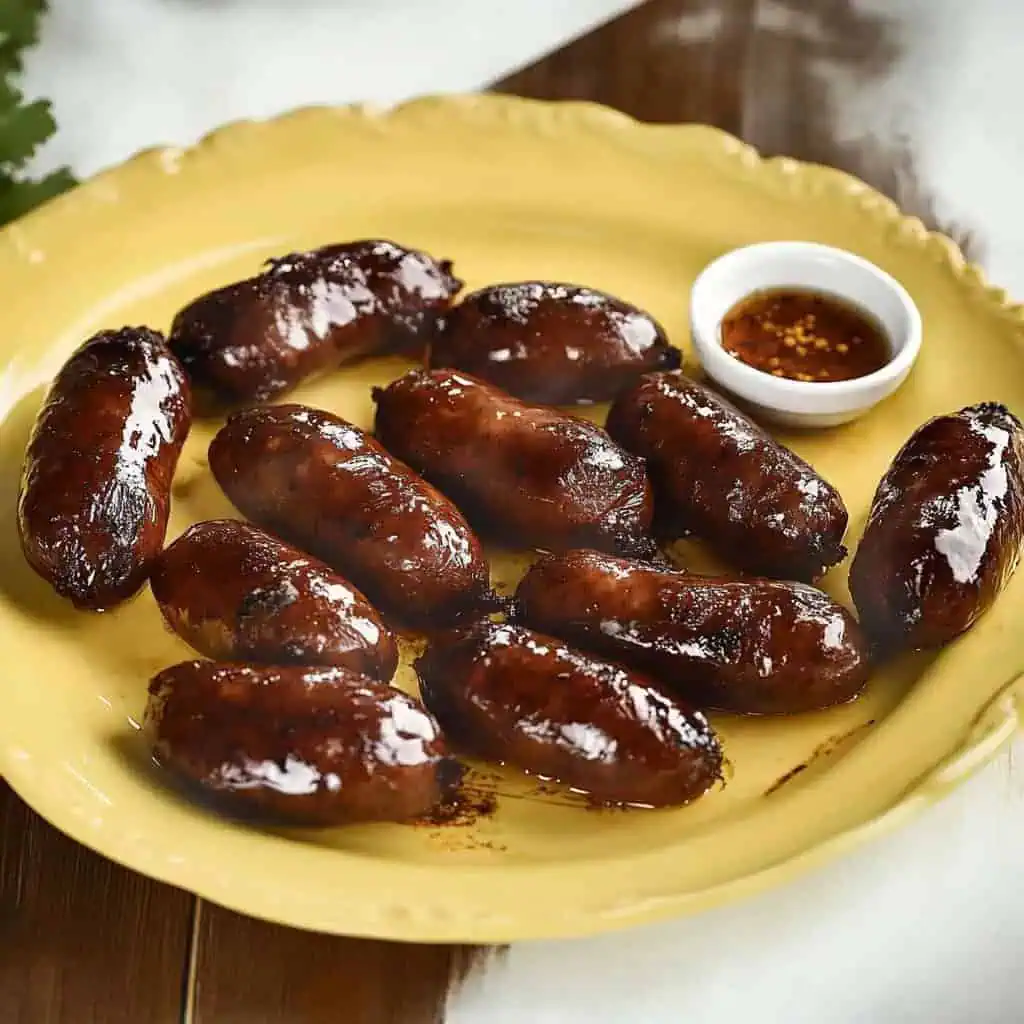
FAQ
Why does Vigan longganisa taste different from other longganisa?
Vigan longganisa features a distinctively garlicky and tangy flavor profile with minimal sweetness, unlike the sweeter varieties from other regions like Pampanga or Lucban. The generous use of garlic and vinegar creates its unique taste.
Is the curing time really necessary?
Yes, the curing period of 3-5 days is essential for developing the characteristic flavor and helping preserve the meat. This process allows the seasonings to fully penetrate the meat and creates that authentic Vigan longganisa taste.
Can I cook these straight from frozen?
It's best to thaw them completely in the refrigerator first for even cooking. Cooking from frozen may result in uneven texture and flavor development.
Why add water when cooking longganisa?
This two-stage cooking method (sometimes called tocino-style) ensures the sausage cooks through properly before browning. The steam helps cook the inside evenly, while the subsequent dry-heat stage creates the caramelized exterior.
How do I know when the longganisa is fully cooked?
Properly cooked longganisa should reach an internal temperature of 160°F (71°C), have a rich reddish-brown color, and the meat should no longer be pink inside.
Can I make a bigger batch and keep it for longer?
Yes, you can make a larger batch and freeze the extra. Raw, properly wrapped longganisa will keep in the freezer for up to 3 months without significant quality loss.
What's the best meat-to-fat ratio for authentic texture?
The traditional ratio is about 80% lean meat to 20% fat, as shown in the recipe (1kg meat to ¼kg fat). This provides the right balance of flavor and texture.
Can I reduce the garlic amount?
While you can adjust to taste, the generous amount of garlic is what gives Vigan longganisa its distinctive character. Reducing it significantly would move away from the authentic flavor profile.
Related
Looking for other recipes like this? Try these:

Authentic Vigan Longganisa Recipe
Equipment
- Large mixing bowl (for combining ingredients)
- Meat grinder or food processor (for mincing meat if not pre-ground)
- Sausage stuffer (kung gagamit ng balat)
- Kitchen twine (pantali sa dulo ng longganisa)
- Plastic container with lid (for curing)
- Heavy-bottomed skillet or kawali (for cooking)
- Meat thermometer (optional, for food safety)
- Wax paper (for skinless version)
Ingredients
For the Sausage Mixture:
- 1 kg lean pork meat minced (karneng baboy na giniling)
- ¼ kg pork fat minced (taba ng baboy na giniling)
- 1 ½ heads garlic crushed (bawang na dinurog)
- ⅓ teaspoon ground bay leaf or 1 leaf finely chopped dahon ng laurel
- 3 tablespoon brown sugar asukal na pula
- ¼ cup soy sauce toyo
- ⅓ cup apple cider vinegar suka
- Salt to taste asin
- 2 teaspoon sweet paprika
- 1 teaspoon coarsely cracked black pepper pamintang durog
- 1 teaspoon red pepper flakes optional
Choose One:
- Sausage casing balat ng longganisa
- 3 tablespoon cornstarch for skinless version (corn starch para sa walang balat)
Instructions
- Here are the simple, step-by-step instructions:
- First, mix the minced pork meat, pork fat, crushed garlic, ground bay leaf, brown sugar, soy sauce, apple cider vinegar, salt, sweet paprika, black pepper, and red pepper flakes (if using) in a large bowl. Let this mixture rest for 1 hour to let the flavors combine.
- If using casings, stuff the meat mixture into the sausage casings. Twist and tie the casings with kitchen string every 4 inches to form individual sausages. If making skinless longganisa, add 3 tablespoons of cornstarch to the meat mixture, then shape small portions into logs about 3 inches long.
- Place the sausages in a covered container. If using casings, refrigerate for 2-5 days to cure. For skinless ones, wrap each piece in wax paper before placing in the container, then refrigerate for 3-5 days.
- When ready to cook, place your desired amount of sausages in a skillet. Add half a cup of water (it should come up about half an inch in the pan). Turn the heat to medium and bring the water to a boil, then let it simmer until all the water evaporates, about 10 minutes.
- Once the water is gone, prick each sausage a few times with a fork. Let them fry in their own rendered fat for 3-5 minutes, until they turn a reddish-brown color and are nicely caramelized. If needed, add a small amount of oil.
- Serve your hot longganisa with garlic rice, eggs cooked your way, and sliced tomatoes. Have some spicy vinegar on the side for dipping.
Tips from Lola's Kitchen
- Use freshly crushed garlic, never pre-minced or powdered
- Keep meat and equipment cold while preparing to ensure proper fat distribution
- Don't skip the curing time - this develops the signature Vigan flavor
- When cooking, don't rush the water evaporation stage
- Score the sausages before frying to prevent bursting
- Save the rendered fat for cooking garlic rice
Nutrition
The Story Behind Vigan Longganisa
Walking through the cobblestone streets of Vigan, Ilocos Sur, you'll find the air filled with the mouthwatering aroma of longganisa being cooked in countless homes and small restaurants. This signature sausage, known for its garlicky-tangy flavor, tells a story that goes back centuries into Philippine culinary history.
Vigan longganisa was born during the Spanish colonial period when the historic city of Vigan was a bustling trading port. Chinese merchants brought their sausage-making techniques, while Spanish colonizers introduced new spices and preservation methods. The Ilocanos then made it their own by adding local ingredients like native vinegar and plenty of crushed garlic, creating something uniquely Bigueño.
What makes Vigan longganisa different from other Filipino sausages is its distinct flavor profile. While other regions like Pampanga and Lucban make their longganisa sweet, Vigan's version proudly stands out with its savory, garlicky punch and tangy finish. The sausages are smaller and thinner than their counterparts, making them perfect for achieving that sought-after crispy exterior when fried.
Today, this beloved breakfast staple remains a source of pride for Vigan, earning a spot on the Philippine Department of Agriculture's Ark of Taste - a catalog of heritage foods that need to be preserved for future generations. Whether enjoyed at a fancy heritage house restaurant or bought fresh from the local market, Vigan longganisa continues to capture the hearts (and taste buds) of both locals and tourists.
Making Vigan longganisa at home connects us to this rich heritage. When you prepare these sausages using traditional methods - letting them cure for days to develop their flavors - you're not just cooking breakfast; you're keeping a precious piece of Filipino food culture alive. Each bite tells the story of our ancestors who crafted these flavor combinations that we still crave today.
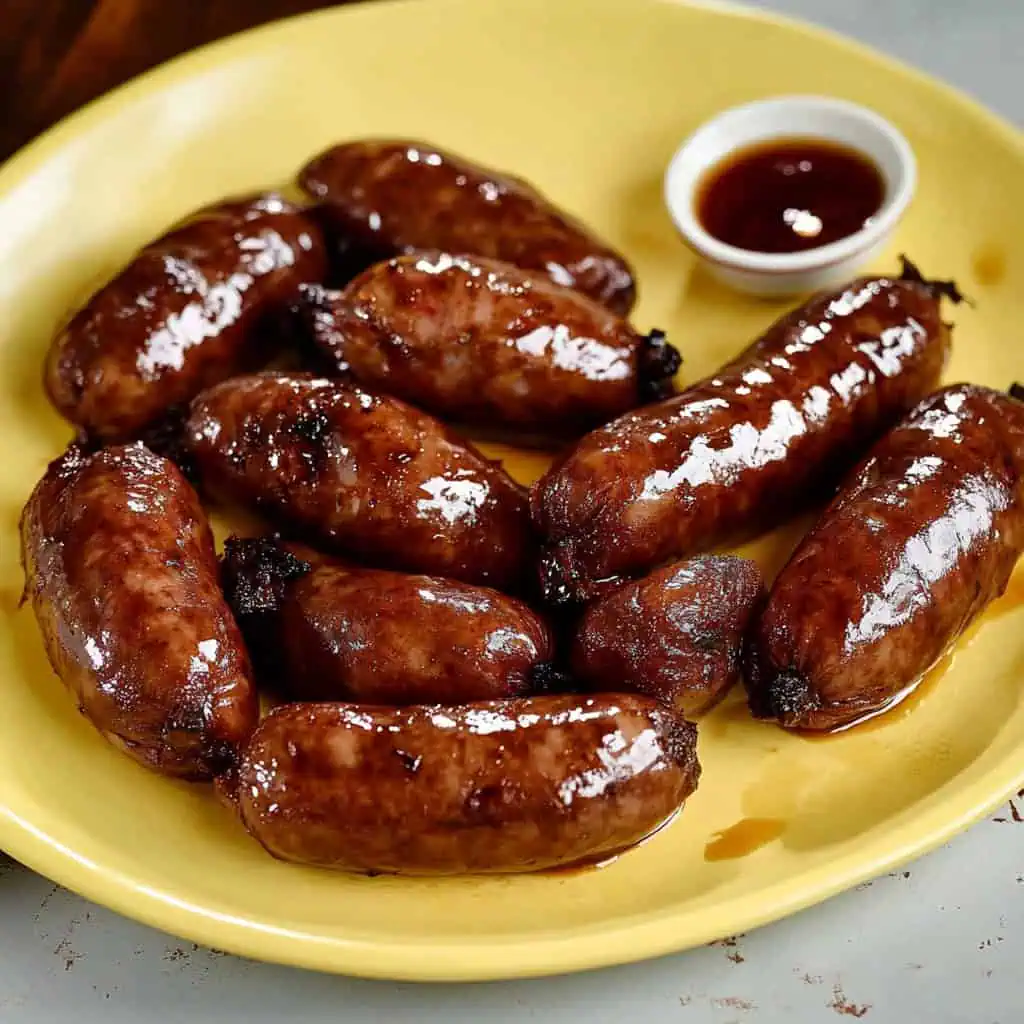








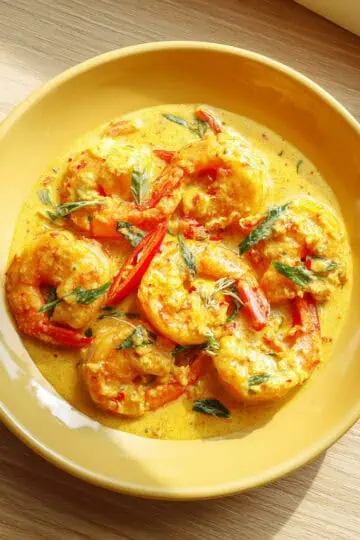
Comments
No Comments